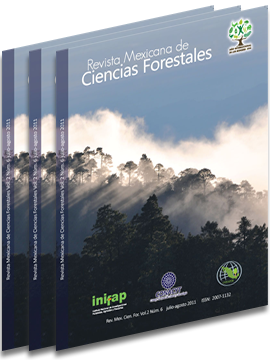THE ENVIRONMENTAL MANAGEMENT UNITS IN THE CONSERVATION OF VEGETATION TYPES IN COAHUILA STATE
DOI:
https://doi.org/10.29298/rmcf.v2i6.578Keywords:
Protected areas, biodiversity, Coahuila, conservation, vegetation types, UMAAbstract
In order to know the way in wfich the 28'i units for management and conservation of wildlife lUMA, according to its initials in Sponish) contribute to the conservation of natural vegetation types of Coahuila, the gap method was used. By the Principal Component Analysis was determined the relationship of the vegelation types of the state in regard to the representativeness in protected oreas (PA). The local UMAs oover 1, 546,778 ha; T2 % of them are found, mainly, in places where the four types of primary vegelation are present, which, according to their extent, would be as follows: desert microphilous scrub, desert rosetophilous scrub,tamaulipean thorn scrub and natural grassland. lf UMA would be considered equivalent to PA for biodiversity conservation they would cover five vegetation types which are gaps in current protected oreas; however, two plant communities: halophilous vegelation and gypsophilous vegetation would be represented in PA below the reach of the national protected average of Mexico ( 12%). Moreaver, four vegelation types, which represent only 12,514 ha, are not represented neither in PA nor in UMA Coahuila's UMAs oover 25% of its tomaulipean thorn scrub and mesquite land extension in primary condition, which are rurrently under-represented in state PA network.. That means, UMA can contribute to biodiversity conservation if they are sustainably managed, proteding naturalland cover.
Downloads
Downloads
Published
How to Cite
Issue
Section
License
The authors who publish in Revista Mexicana de Ciencias Forestales accept the following conditions:
In accordance with copyright laws, Revista Mexicana de Ciencias Forestales recognizes and respects the authors’ moral right and ownership of property rights which will be transferred to the journal for dissemination in open access.
All the texts published by Revista Mexicana de Ciencias Forestales –with no exception– are distributed under a Creative Commons License Attribution-NonCommercial 4.0 International (CC BY-NC 4.0), which allows third parties to use the publication as long as the work’s authorship and its first publication in this journal are mentioned
The author(s) can enter into independent and additional contractual agreements for the nonexclusive distribution of the version of the article published in Revista Mexicana de Ciencias Forestales (for example, include it into an institutional repository or publish it in a book) as long as it is clearly and explicitly indicated that the work was published for the first time in Revista Mexicana de Ciencias Forestales.
For all the above, the authors shall send the form of Letter-transfer of Property Rights for the first publication duly filled in and signed by the author(s). This form must be sent as a PDF file to: ciencia.forestal2@inifap.gob.mx
This work is licensed under a Creative Commons Attribution-Noncommercial 4.0 International license.






